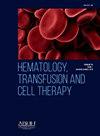间充质光性肿瘤一例成功报告
IF 1.8
Q3 HEMATOLOGY
引用次数: 0
摘要
低磷血症间充质肿瘤(HMT)是罕见的,起源不确定,可能导致由副肿瘤综合征引起的骨软化症。临床表现主要是肿瘤细胞促进磷酸酶分泌,导致肾脏磷酸盐排泄过多,骨折、骨痛、低磷血症、骨化三醇水平过低。由于hmt相对较小且隐匿,因此通过解剖成像定位具有挑战性。报告我们描述了一个案例,说明了核医学识别HMT的潜力。52岁女性患者主诉弥漫性疼痛,尤以髋部、胸腔和足部疼痛一年多。髋关节核磁共振成像(MRI)显示双侧股骨头无血管坏死。为了评估可能的骨代谢改变,如甲状旁腺功能亢进,她接受了骨显像检查,未发现甲状旁腺功能亢进的迹象,但发现(除了缺血性坏死外)肥厚性骨关节病的迹象,提示副肿瘤综合征。实验室检查显示甲状旁腺激素、低磷血症和磷尿正常。患者开始口服磷替代,这只能部分减轻骨痛。患者接受FDG-18F PET/CT检查寻找隐匿性肿瘤,结果为阴性。考虑到患者的磷尿以及软组织隐匿性非间质肿瘤引起的低磷血症和骨软化症的报道,考虑产生磷酸盐的HMT假说。这些肿瘤主要发生在下肢,产生疼痛并易发生软骨下骨小骨折(更常见于股骨头),并表达生长抑素受体。因此,我们使用了dotate - 68ga PET/CT来定位这个表达生长抑素的隐匿性肿瘤。图像显示左侧大腿肌深部一个0.5 cm的肌肉内结节,生长抑素受体高表达。为了准备手术,对左大腿进行MRI检查以定位DOTA-68Ga摄取的结节。MRI显示结节位于肌肉深处,靠近左股血管神经束。由于病变体积小,位置深,靠近神经血管束,采用DOTA-68Ga放射引导手术切除结节。组织病理学结论结节符合低磷血症间充质瘤。肿瘤切除后,磷酸盐水平恢复正常,疼痛消失,患者报告身心健康状况改善。综上所述,由于副肿瘤综合征的影像学特征,骨扫描对于鉴别隐匿性肿瘤的可能性至关重要,而dotate - 68ga PET/CT对肿瘤的定位至关重要。本文章由计算机程序翻译,如有差异,请以英文原文为准。
MESENCHYMAL PHOSFATURIC TUMOR: A CASE REPORT OF SUCCESS
Introduction/Justification
Hypophosphatemia mesenchymal tumors (HMT) are rare, of uncertain origin, and may cause osteomalacia derived from paraneoplastic syndrome. The clinical manifestations are caused mainly by phosphatase secretion promoted by the tumor cells, leading to excessive kidney excretion of phosphate, fractures, bone pain, hypophosphatemia, and low calcitriol levels. HMTs are challenging to locate through anatomic imaging because they are relatively small and occult.
Report
We describe a case that illustrates the potential of nuclear medicine to identify HMT. A 52-year-old female patient complained of diffuse pain, especially in the hips, rib cage, and feet, for over one year. Magnetic resonance imaging (MRI) of the hip demonstrated bilateral avascular necrosis of the femoral heads. To evaluate a possible osteometabolic alteration, such as hyperparathyroidism, she underwent bone scintigraphy, which did not reveal signs of hyperparathyroidism but identified (in addition to the avascular necrosis) signs of hypertrophic osteoarthropathy, suggesting paraneoplastic syndrome. Laboratory tests showed normal PTH, hypophosphatemia, and phosphaturia. The patient initiated oral phosphorus replacement, which only partially reduced bone pain. She was submitted to an FDG-18F PET/CT to search for an occult tumor, which was negative. Considering the patient´s phosphaturia and reports of hypophosphatemia and osteomalacia caused by occult non-mesenchymal tumors of the soft tissues, the hypothesis of phosphate-producing HMT was considered. These tumors arise mainly in the lower limbs, generate pain and a predisposition to small fractures in subchondral bones (more common in the femoral heads), and express somatostatin receptors. Thus, a DOTATATE-68Ga PET/CT was performed to locate this somatostatin-expressing occult tumor. The images showed a 0.5 cm intramuscular nodule with hyperexpression of somatostatin receptors deep within the left thigh muscle. To prepare for surgery, an MRI of the left thigh was performed to locate the nodule with DOTA-68Ga uptake. MRI showed the nodule was quite deep within the muscle and close to the left femoral vascular-nerve bundle. Due to the lesion's small size, deep location, and proximity to the neurovascular bundle, radioguided surgery with DOTA-68Ga was performed to remove the nodule. Histopathology concluded the nodule was consistent with a hypophosphatemia mesenchymal tumor. After the removal of the tumor, the phosphate level normalized, the pain disappeared, and the patient reported improved physical and mental health.
Conclusion
In conclusion, a bone scan was essential to identify the possibility of an occult tumor due to the imaging characteristics of paraneoplastic syndrome, and the DOTATATE-68Ga PET/CT was vital to locate the tumor.
求助全文
通过发布文献求助,成功后即可免费获取论文全文。
去求助
来源期刊

Hematology, Transfusion and Cell Therapy
Multiple-
CiteScore
2.40
自引率
4.80%
发文量
1419
审稿时长
30 weeks
 求助内容:
求助内容: 应助结果提醒方式:
应助结果提醒方式:


